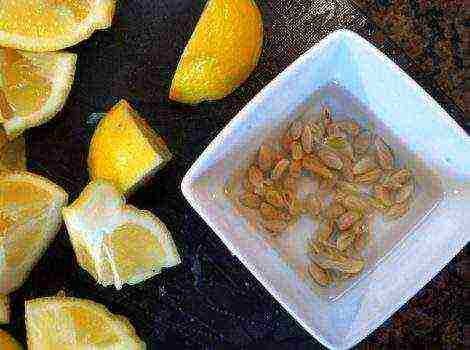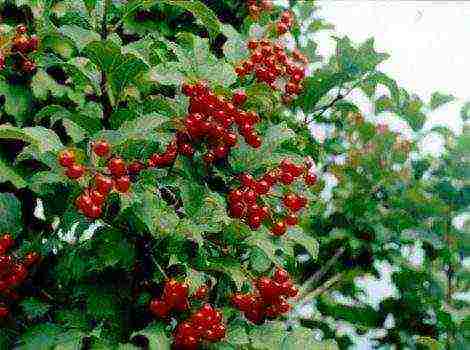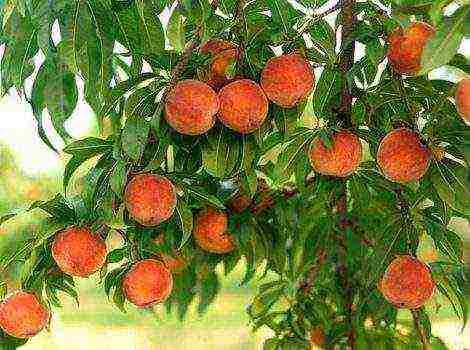Content
Proper planting and care of the almond tree
Almonds are tall trees or bush, which belongs to the genus Plum and the Pink family. Many people think that almonds are nuts, but in reality they are not, they are stone fruits.
Description and flowering of an ornamental shrub
The almond tree reaches a height of 4-6 meters, and the shrub 2-3 meters. The rhizome consists of 3-5 skeletal roots, which are able to penetrate deep into the soil, thereby protecting against drying out.
The plant is quite branchy, while it consists of two types of shoots, which include shortened generative and elongated vegetative ones.
Dark green leaves are attached on brown petioles and have a lanceolate shape with a pointed tip.
Flowers such a plant consists of 5 petals painted in white or light pink. On average, the diameter of one flower is 2.5 centimeters.
Almond fruit Is a dry and velvety drupe with a leathery and fleshy green pericarp.
After drying, the pulp is very easily separated from the oval-shaped edible bone and is 2.5 - 4 centimeters long. It is characterized by the presence of a large number of furrows.
The first fruiting occurs in the 4-5 year of the tree's life., but in full force it appears only for 10-12 years. With good care, the shrub bears fruit for 30-50 years.
Besides getting fruit almonds are also grown for decorative purposes... The pink or white foam of the flowers of such a tree not only decorate the garden in early spring, but also exude a unique aroma.

Almonds are a plant that needs to be pollinated beforehand. There are two types of trees:
- the former need cross-pollination, therefore, at least 3 pollinators are planted next to the fruiting almonds, the flowering time of which must coincide;
- the latter are pollinated by bees, therefore, it is desirable that 2-3 hives stand next to the plant.
Initially, it was believed that almonds can only be grown in the southern regions, but with the development of scientific technology, breeders have developed varieties that, with proper shelter, can survive even the most severe winter.
Varieties
Sweet varieties of almonds are grown in the culture, the following types are especially popular:
- Anniversary - the variety blooms rather late, has good drought resistance. The skin is of medium thickness and the kernel is sweet, firm and dry;
- Ayudagsky - this variety is late-ripening and early-fruiting, the first fruiting occurs already at the 3rd year of the tree's life. Fruits, covered with a soft shell, are a dense, slightly flattened oval core of light brown color;
- Sevastopol - these almonds boast excellent resistance to heat and drought, besides, they bring a huge amount of harvest. The shell of the fruit is soft, and the kernels themselves are dense, sweet, colored in white;
- Mangul - this late-ripening variety is not afraid of drought. Hard and dense kernels with increased oiliness are covered with a soft shell. A distinctive feature will be good immunity to most diseases and pests;
- Dessert - such a self-fertile almond is well suited for growing in central Russia, because it is not afraid of recurrent frosts and frostbite of flower buds. The shell is soft and rough. The oval kernels are very sweet and oily. Primorsky or Spicy almonds are usually used as pollinators for this variety.
Rules for planting an almond tree in open ground
It is best to grow almonds from annual seedlings, which are placed in open ground at the beginning of March or at the end of November.
As a place to plant a plant choose a sunny area, protected from draft and gusty winds, almonds can also grow well in partial shade.
Before planting a plant, you need to prepare a hole. In the fall, two weeks before planting, pits are dug, the diameter and depth of which will be 50-70 centimeters.
If almonds are planted in groups, then the distance between individual trees should be 3-4 meters, and between rows 5-6 meters.
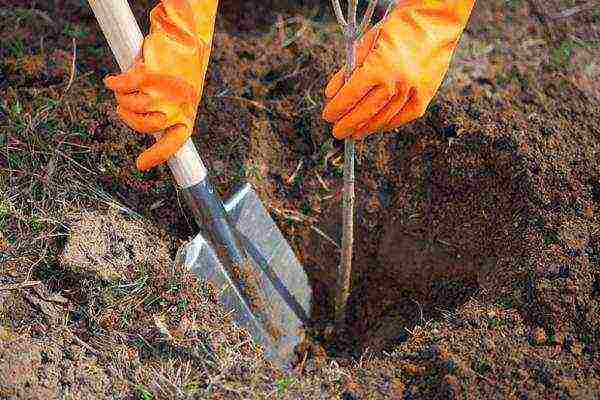
A drainage layer is laid at the bottom of each pit, consisting of crushed stone or gravel. Then fertile soil is placed in them, consisting of the following elements:
- 1 part sand;
- 2 parts of humus;
- 3 pieces of leafy land;
- 5-6 kilograms of rotted manure or humus;
- 500 grams of superphosphate;
- in the presence of acidic soil, 200-300 grams of dolomite flour or lime are additionally introduced into it.
After the pit has infused enough you can start planting a tree:
- initially, a support with a height of 1-1.5 meters is dug in the center of the pit;
- then a hill of earth is built around it;
- the seedling is placed on a mound in such a way that the root collar is 3-5 centimeters above the ground;
- at the next stage, the pit is covered with fertile soil, tamped and carefully watered;
- as soon as the water is completely absorbed, the seedling is tied to a support and the soil is mulched with a 3-5 cm layer of peat or dry leaves.
When carrying out spring planting, the pit is also prepared in the autumn.
How to plant almonds correctly:
Almond care
Almond care consists of several standard procedures that must be followed when growing almost all fruit trees.
For the best fruiting almonds need regular watering... Young plants are watered every 2 weeks, and adults 1 every 20-25 days.
Loosening the trunk circle has a beneficial effect on the growth of the tree. The first time such work is carried out at the end of March to a depth of 10-12 centimeters.
Then, during the entire growing season, another 3-4 loosening is carried out, but already to a depth of 6-8 centimeters. It is also necessary to remove weeds in a timely manner.
In the fall, the following mixture is introduced into the trunk circle for digging:
- 1 kilogram of manure;
- 20 grams of potassium sulfide;
- 40 grams of superphosphate.
For the first 5-7 years of the life of trees in the aisles, it is recommended to grow green manure.
In Siberia, legumes, steppe, low or Russian almonds can be grown without shelter. In the central strip, three-lobed almonds grow well.
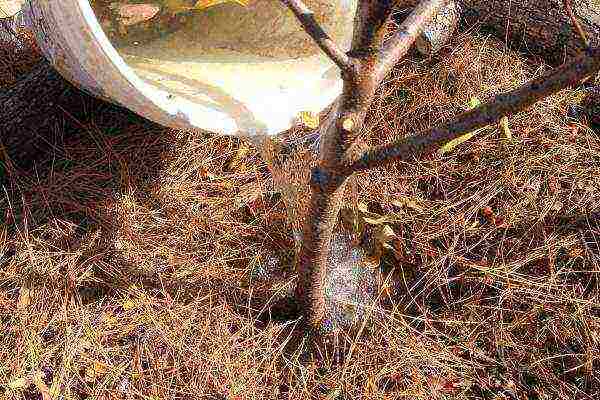
Pruning
In early spring, before bud break all frozen, broken, diseased or deforming branches must be removed.
After the end of flowering, you can start formative pruning., during which 3 tiers of skeletal branches are derived:
- in the first year, three branches are chosen, located 15-20 centimeters from each other and shortened to a length equal to 15 centimeters;
- the next 2-3 years, 3 tiers are formed on the central conductor, located at a distance of 20-30 centimeters;
- shoots that are insignificant for the formation of the crown are pinched several times over the summer;
- the rest are cut to 50-60 centimeters;
- at the end of the work, the central conductor is shortened so that the distance between it and the upper tier is 55-60 centimeters.
In autumn, after the leaves fall, carry out sanitary and anti-aging pruning. That is, remove all dry, diseased, broken, growing in the wrong direction and thickening the crown of the branches.
It is worth remembering that when cutting thick branches, the cut site must be processed with garden varnish.

Diseases and pests
Most often, the following types of diseases are found on almonds:
- Cercosporosis - initially brown spots with a diameter of 2-4 millimeters appear on the leaves, on which you can see a gray bloom. Then the center of the leaf dries up and falls off.
- Scab Is a fungal disease that affects the leaves, flowers and shoots of a tree.
- Rust - red spots appear on the upper side of the leaf, and brown pads appear on the inner side. Over time, the leaves dry and fall off.
- Hole spot - the disease affects all parts of the tree. It can be found on the leaves, because characteristic spots of red shades with a dark border around the edges appear on them.
- Gray rot - brown spots and gray fluffy bloom appear on the shoots.
Of the pests on almonds, you can find insects such as seed eater, aphid, leaf roll or spider mite.
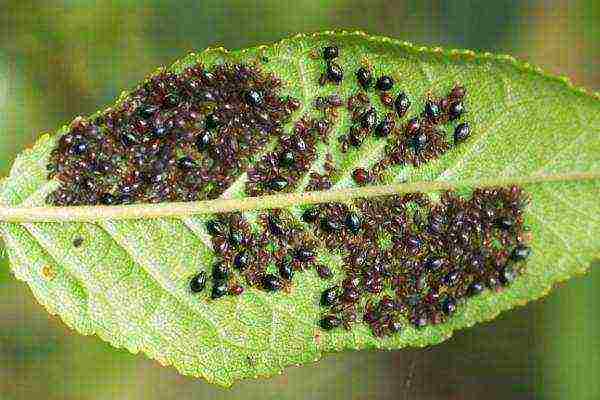
As a pest control, trees must be treated with insecticides, which include Actellik, Fufanon, Tagore.
Biotlin or Antitlin are used against aphids. You can get rid of a spider mite with the help of Apollo, Agravertin or Fitoverm preparations.
As you know, it is much better to prevent the occurrence of any trouble than to cure it, therefore preventive measures will be extremely effective:
- in early spring, before the formation of buds, the tree and the soil around it are treated with 1 percent solution of Brodsky's liquid;
- after the end of the leaf fall, the treatment should be repeated;
- the best preventive measure will be adherence to cultivation agrotechnics. This includes proper watering, weed removal, and sanitary pruning.
The almonds are removed only after the green outer shell darkens and becomes easily separated from the kernel.
The use of a flowering tree in landscape design
Almonds have a very beautiful and unusual flowering., for which it is very often planted for decorative purposes. Early flowers can only decorate a waking garden and create a spring mood.
The almond tree is an amazing flowering plant, which in modern conditions can be grown in any corner of the country. If all the recommendations are followed correctly, you can get very tasty bone fruits.
